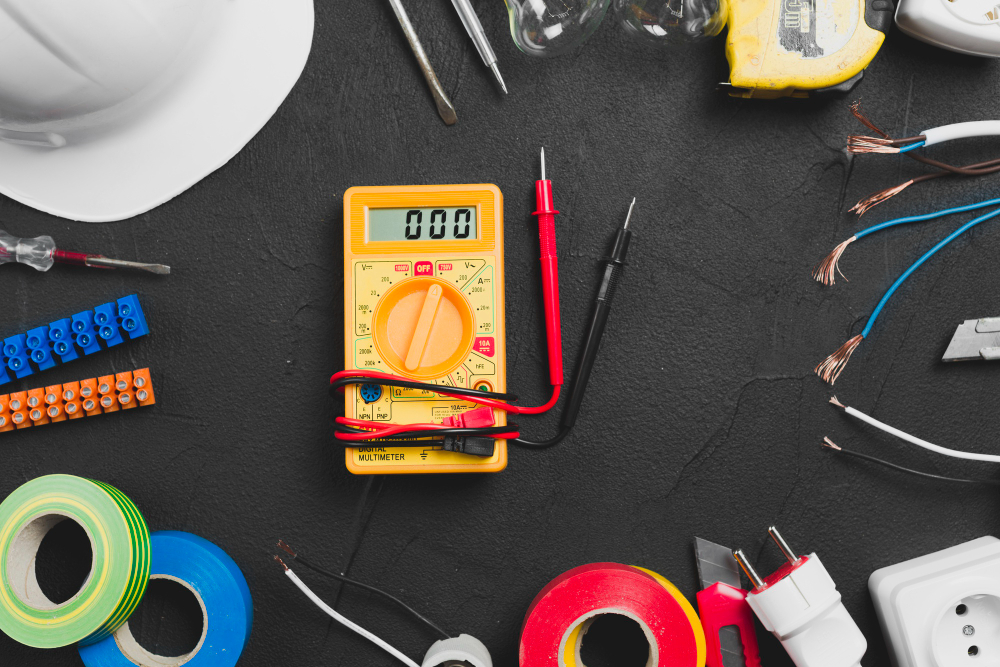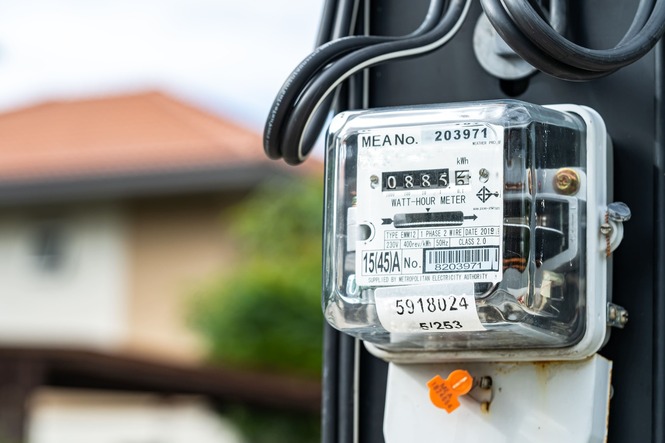5 Perbedaan Multimeter Digital dan Analog dalam Pengukuran Listrik

Perbedaan multimeter digital dan analog terletak pada teknologi yang digunakannya. Secara umum, kedua jenis multimeter tersebut sama, baik dari fungsi maupun cara penggunaannya. Hanya saja, multimeter digital yang muncul belakangan juga memiliki fitur-fitur tambahan yang membedakannya dengan multimeter analog.
Sebelum beranjak pada pembahasan tentang perbedaan multimeter digital dan analog, Mitra Cipta Hardi Elektrindo akan membahas terlebih dahulu mengenai pengertian dan fungsi multimeter secara umum sebagai alat ukur parameter listrik yang penting dalam pekerjaan terkait kelistrikan.
Baca Juga: Cara Membaca Multimeter Digital dengan Mudah dan Benar, Semua Pemula Bisa!
Pengertian dan Fungsi Multimeter
Pengertian multimeter adalah alat ukur yang digunakan untuk mengukur beberapa parameter listrik, seperti arus, tegangan, dan hambatan pada suatu perangkat atau benda yang memiliki sistem kelistrikan. Contoh penggunaan alat ini misalnya pada stopkontak, saklar, alat-alat elektronik rumah tangga, hingga aki kendaraan.
Fungsi multimeter terhitung cukup banyak, di antaranya untuk mengetahui besaran parameter listrik, serta membantu teknisi mengetahui adanya masalah pada sistem kelistrikan di dalam suatu perangkat. Beberapa parameter listrik yang dapat diuji atau diukur menggunakan multimeter adalah arus, tegangan, hambatan, nilai kapasitansi, frekuensi sinyal, dan lain-lain.
Jenis multimeter terbagi menjadi dua, yaitu multimeter digital dan multimeter analog. Meskipun secara fungsi sama, tetapi kedua jenis multimeter tersebut juga memiliki perbedaan yang penting untuk diketahui. Dengan memahami perbedaan multimeter digital dan analog, Anda akan lebih mudah menentukan perangkat terbaik untuk membantu pekerjaan kelistrikan.
Perbedaan Multimeter Digital dan Analog
Multimeter analog menampilkan hasil pengukuran pada defleksi jarum dan skala, sedangkan multimeter digital menampilkan hasil pengukuran pada layar LCD. Selain itu, terdapat perbedaan multimeter digital dan analog lainnya yang penting diketahui.
Melansir dari Kalibrasi dan Tutorialspoint, berikut beberapa perbedaan multimeter digital dan analog sebagai alat ukur listrik.
1. Tampilan Layar
Perbedaan multimeter digital dan analog yang pertama terletak pada tampilan layarnya. Seperti namanya, multimeter digital menggunakan layar digital untuk menunjukkan hasil pengukuran. Hasil pengukuran tersebut dinyatakan dalam angka yang tampil sesuai pengukuran yang dilakukan. Dengan demikian, penguji bisa langsung mengetahui dan membaca tampilan secara langsung.
Di sisi lain, multimeter analog masih sederhana. Tampilan layar hasil pengukurannya menggunakan jarum dengan skala yang sudah tertera. Membaca hasil pengukuran pada layar multimeter analog masih terbilang cukup rumit. Teknisi harus menguasai alat tersebut agar tidak ada kesalahan pembacaan pada jarum yang bergerak.
2. Desain Teknologi
Desain teknologi adalah perbedaan multimeter digital dan analog yang penting. Teknologi pada multimeter analog memanfaatkan galvanometer dengan magnet untuk menggerakan kumparan. Lalu, jarum penunjuk dipasang pada kumparan yang bergerak pada skala untuk menunjukkan hasil pengukuran.
Pada multimeter digital, teknologi yang digunakan adalah dengan memanfaatkan rangkaian elektronik kompleks seperti ADC, encoders, logic controller, digital display, dan lainnya yang terhubung dalam satu unit untuk menghasilkan pengukuran yang akurat. Karena hal ini, multimeter digital membutuhkan suplai daya dari baterai untuk menjalankannya.
3. Cara Kerja
Selanjutnya, perbedaan multimeter digital dan analog yang ketiga terletak pada cara kerjanya. Multimeter analog yang aktif akan menggunakan galvanometer untuk pengukuran. Pasalnya, galvanometer itu sensitif terhadap arus yang melalui sistem. Jadi, ketika multimeter dihubungkan ke perangkat, posisi jarum akan bergerak sepanjang skala. Dengan demikian, multimeter analog tidak perlu ADC untuk mengonversi sinyal.
Sebaliknya, multimeter digital membutuhkan ADC untuk mengubah sinyal analog menjadi digital dalam pengukuran parameter tegangan. Dengan adanya ADC, proses pengukuran dan pembacaan pada multimeter digital menjadi lebih akurat dan stabil.
4. Fitur dan Kapasitas
Multimeter analog biasa hanya dapat mengukur parameter listrik dasar, seperti arus, tegangan, dan resistansi. Oleh karena itu, multimeter analog juga dikenal dengan nama AVO Meter, yaitu singkatan dari Ampere, Volt, dan Ohm yang merupakan satuan dari arus, tegangan, dan hambatan. Alat ukur ini masih sederhana dan memiliki keterbatasan dibandingkan dengan multimeter digital.
Perbedaan multimeter digital dan analog ini cukup penting. Kebanyakan multimeter digital dapat mengukur beberapa besaran parameter listrik, seperti arus, resistansi, tegangan, kapasitansi, induktansi, dan lainnya. Multimeter digital juga digunakan untuk menguji dioda dan transistor. Tak hanya itu, beberapa model alat ukur ini menyediakan fitur modern yang beragam, seperti kalibrasi otomatis, auto-ringing, hingga fitur True-RMS.
5. Tampilan Fisik dan Harga
Perbedaan multimeter digital dan analog yang terakhir adalah dari tampilan fisik serta harganya. Multimeter analog biasanya memiliki ukuran yang lebih besar dibandingkan multimeter digital yang relatif kecil. Selain itu, pada multimeter analog terdapat tombol seperti sakelar yang digunakan untuk memilih jenis pengukuran, seperti arus, tegangan, atau hambatan, yang dapat diputar sesuai kebutuhan. Pada multimeter digital modern, pengukuran dapat diatur secara otomatis.
Dari segi biaya atau harga pun berbeda. Multimeter analog biasanya lebih murah karena masih menggunakan teknologi sederhana. Sebaliknya, multimeter digital lebih mahal karena teknologi modern dan menyediakan fitur yang lebih pengukuran listrik yang lebih lengkap.
Pilihan Multimeter Digital di Mitra Cipta Hardi Elektrindo dan Hokione
Setelah mengetahui perbedaan multimeter digital dan analog, Anda mungkin sudah memutuskan bahwa pilihan alat ukur listrik terbaik saat ini adalah multimeter digital. Sebagai distributor resmi peralatan elektrikal dan mekanikal terpercaya di Indonesia, Mitra Cipta Hardi Elektrindo punya rekomendasi perangkat multimeter digital terbaik dan berkualitas. Berikut beberapa pilihan multimeter digital yang tersedia:
1. Fluke 17B MAX Digital Multimeter
Multimeter digital ini dapat melakukan pengukuran parameter listrik yang lengkap, dari tegangan, arus, hingga resistansi. Salah satu fitur tambahan pada multimeter digital Fluke 17B MAX adalah bisa mengeluarkan alarm suara dan visual saat terjadi kesalahan penggunaan sehingga menghindari kerusakan pada perangkat.
2. Fluke 179 True-RMS Digital Multimeter
Multimeter digital Fluke 179 True-RMS dapat melakukan pengukuran dasar parameter listrik ditambah keunggulannya yang dilengkapi dengan fitur pengukuran True-RMS. Ini adalah fitur untuk mengukur nilai efektif (RMS) sinyal AC secara akurat, termasuk bentuk gelombang non-sinusoidal. Dengan adanya fitur ini, multimeter digital dapat mengukur lebih akurat dan andal dalam menghadapi masalah selama proses troubleshooting.
3. Fluke 87V Industrial Multimeter
Terakhir, rekomendasi multimeter digital yang ada di Mitra Cipta Hardi Elektrindo dan Hokione adalah Fluke 87V Industrial Multimeter. Perangkat ini didesain tangguh untuk lingkungan industrial dengan kemampuan mengukur tegangan serta frekuensi yang akurat pada kecepatan penggerak motor yang dapat disesuaikan dan peralatan berderau elektronik. Fitur tambahannya juga termasuk termometer bawaan untuk membaca suhu perangkat.
Baca Juga: Cara Menggunakan Multimeter Digital untuk Mengukur Arus, Tegangan, dan Hambatan Listrik
Powered by Froala Editor

Selain perbedaan multimeter digital dan analog, Mitra Cipta Hardi Elektrindo juga memiliki informasi lainnya tentang kelistrikan serta perangkat elektrikal dan mekanikal yang dapat menambah wawasan Anda. Ikuti dan kunjungi blog kami untuk beragam informasi menarik lainnya. Dan jika Anda sedang mencari produk multimeter digital atau alat-alat listrik yang andal dengan harga terjangkau, Anda bisa menemukannya di Mitra Cipta Hardi Elektrindo dan Hokione, distributor resmi FLUKE terpercaya di Indonesia.
Powered by Froala Editor
Related News


